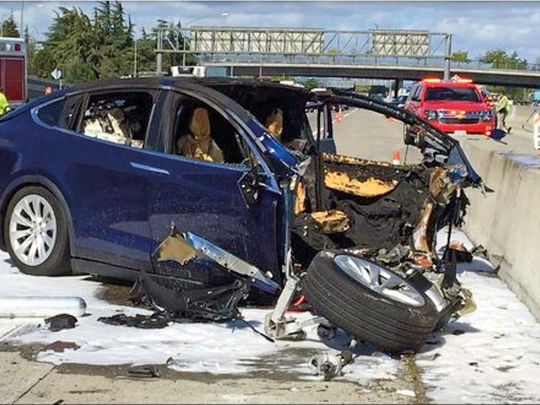
New York
Tesla Inc said computer logs of the Model X vehicle involved in a fatal crash a week ago showed the driver didn’t have his hands on the steering wheel for six seconds before the accident.
Wei Huang, 38, died March 23 when his vehicle hit a highway barrier in California and caught fire. The damage to the vehicle was exacerbated by a safety bulwark that hadn’t been replaced after a prior accident, the company wrote in a blog post published March 30.
“The driver had received several visual and one audible hands-on warning earlier in the drive,” Tesla said. “The driver had about five seconds and 150 metres of unobstructed view of the concrete divider with the crushed crash attenuator, but the vehicle logs show that no action was taken.”
The collision occurred days after a separate Uber Technologies Inc accident killed a pedestrian, raising fresh questions about self-driving features and sending ripples across the broader autonomous-vehicle industry. Elon Musk’s electric carmaker shed more than $5 billion last week and has lost almost a quarter of its value since February 23 amid concerns about production of its vehicles, recalls and the crash.
Wei Huang’s LinkedIn profile identified him as a software engineer who joined Apple Inc in November.
Autopilot statistics
Tesla defended its Autopilot programme in the blog post, saying the system made it 3.7 times less likely for a person in the US to be involved in a fatal accident. Statistics for the US show one automotive fatality every 86 million miles driven across all vehicles, compared with 320 million miles in those equipped with Autopilot hardware, it said.
“None of this changes how devastating an event like this is or how much we feel for our customer’s family and friends,” Tesla wrote, pushing back against criticism that it lacked empathy for bringing up safety statistics to counter attacks on its programme. “We must also care about people now and in the future whose lives may be saved if they know that Autopilot improves safety.”
Tesla’s approach with Autopilot has been to field a suite of driver-assistance features that are continuously improved via over-the-air software updates and help build toward more advanced autonomous capabilities. Tesla says that all cars now being made at its factory in Fremont, California have the hardware needed for “full self-driving capability at a safety level substantially greater than that of a human driver.”












